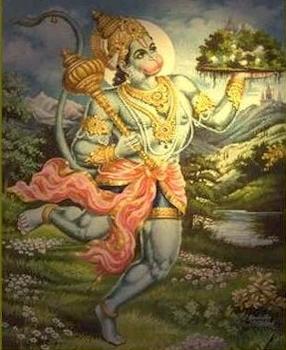 |
 |
 |
 |
 |
|
|||||||||||||||||
| The time is | ||||||||||||||||||||||
 |
||||||||||||||||||||||
| |
||||||||||||||||||||||
| |
||||||||||||||||||||||
|
|
||||||||||||||||||||||
| |
||||||||||||||||||||||
| |
||||||||||||||||||||||
| |
||||||||||||||||||||||
 |
||||||||||||||||||||||
| Legend
of Hanuman . |
||||||||||||||||||||||
 |
In Hinduism, Hanuman (Sanskrit: hanumat;
nominative singular hanuman) is a vanara who aided Rama (an avatar of
Vishnu) in rescuing his wife, Sita, from the Rakshasa king Ravana. He
symbolizes the pinnacle of bhakti, and is seen by some to have also
been an avatar of Shiva. He is more well-known as the son of Vayu deva,
or the wind god. He is believed by some scholars to be a source for
the Chinese mythological character Sun Wukong. |
|||||||||||||||||||||
Legend of Hanuman |
||||||||||||||||||||||
He is symbolized in Hinduism for his unwavering dedication to righteousness, unstinting performance of entrusted duties, and unfailing talents in serving his master Rama. He is given the role of a guru in several South Indian traditions, for his uniting Rama with Sita is likened to that of a teacher helping an individual soul realize the divine. Hanuman is the epitome of Knowledge, Bhakti, Valour, Righteousness and Strength. These qualities never mix with one another. Shri Hanuman is the personification of all the good in this Creation. He is easily reachable - Just by chanting the name - 'Ram'. Birth Hanuman is born in Treta Yuga as the son of an apsara (a celestial), named Punjisthala, who by a curse becomes Anjana, a female vanara. Hence Hanuman is also called Änjanèya (the son of Anjana). She is the wife of Kesari, a mighty vanara who once killed a mighty elephant that was troubling sages and hermits. He therefore got the name of Kesari, meaning a lion, and is also called Kunjara Südana, the elephant killer. One day when Anjana was on a mountain peak, Vayu, the wind god, came by, and generated a forceful blow of air, and her clothes slipped off her body. Vayu was incited by her charm and possessed her, with her consent. She thus gave birth to Hanuman. Hence Hanuman is also known as Vayu-putra (son of the wind). Hanuman's birthday is celebrated as Hanuman Jayanti. Hanuman was named Maruti after his birth. During the course of his childhood, he was injured on the cheek by Indra, who named him Hanuman (see below).
Indra, the king of devas and the upholder of universal laws, observed this. He hurled his weapon, the Vajra (thunderbolt), which struck Maruti on his chin. Maruti fell back down to earth and became unconscious. Vayu, the wind god, Maruti's father, was upset by this and went into seclusion. As living beings began to get asphyxiated, to pacify Vayu Deva, Indra withdrew the effect of his thunderbolt, and the devas revived him and blessed him with multiple boons. However, as the vajra had left a mark on Maruti's chin (hanuhH in Sanskrit), he was called Hanuman. On ascertaining that Surya is an all-knowing teacher, Hanuman raised his body into an orbit around the sun and requested that Surya accept him as a student. But Surya declined to accept him claiming that he always had to be on the move in his chariot. But Hanuman, undeterred by Surya's travel, enlarged his body. He placed one leg on the eastern ranges and the other on the western ranges and with his face turned toward the traveling sun, made his request again. Pleased by his persistance, Surya taught all of his knowledge to Hanuman. Hanuman's choice of Surya as his teacher is said to signify Surya as a Karma Saakshi, an eternal witness of all deeds. Hanuman was mischievous in his childhood, and sometimes teased the meditating sages by snatching their personal belongings and by disturbing their well-arranged articles of worship. Finding his antics intolerable, but realizing that Hanuman was still a child, yet invincible by the blessings of various celestials, the sages gave him a minor curse. By this curse Hanuman lost the ability to remember his own might, and only recollected it when others reminded him about it at the appropriate time. It is hypothesized that without this curse, the entire course of the Ramayana war might have been different, for he demonstrated phenomenal abilities during the war, despite the curse. Hanuman and Vinayaka are two gods who are not afflicted by Saturn. There is also a myth that all the planets are under control on his tail. Whoever worships Hanuman is granted with fortitude and strength.
While in exile, Rama enlisted the help of the vanaras in his search for Sita. A group of vanaras sent on a search mission reached the southern seashore. Upon encountering the vast ocean, every vanara began to plead his inability to jump across the water. Hanuman too was saddened at the possible failure of his mission, until the other vanaras began to extol his virtues. Hanuman then recollected his own prowess, enlarged his body and jumped across the ocean. Hanuman then entered Lanka and found Sita. Hanuman's conveying the message of Rama to Sita is likened to that of a divine teacher, teaching a pupil about the Supreme God. After meeting Sita, Hanuman began to gradually destroy the palaces and properties of Lanka. To subdue him, Ravana's son Indrajit used the Brahmastra. Even though Brahma had blessed Hanuman with immunity against the astra, Hanuman, out of respect to Brahma, let himself be bound by the weapon. Brought before the court of Ravana, Hanuman used the opportunity to assess the strength of Ravana's army. As a punishment to Hanuman, Ravana ordered his tail to be lit. As the attendants attempted to wrap cloth around his tail, Hanuman began to lengthen his tail. After frustrating Ravana's attendants for a while, Hanuman allowed his tail to be lit, but escaped from his captors while his tail was on fire. He then burnt down much of Lanka before heading back to Rama. During the war, when Lakshmana, the brother of Rama, is severely wounded, Hanuman was sent to fetch the Sanjivani, a powerful life-restoring herb to revive him. Ravana realised that if Lakshman died, the war would be lost, and so had his uncle tempt Hanuman with luxury. However, Hanuman was tipped off by a crocodile and killed the evil demon. Unable to find the specific herb before nightfall, Hanuman again displayed his prowess by lifting the entire mountain Dronagiri and bringing it to the battle field, thus helping others find the herb to revive Lakshmana. In another incident during the war, Rama and Lakshmana are captured by Mahiravana (also called Ahiravana), and are held captive in his palace in Patalpuri or Patala (the nether world). In search of them, Hanuman entered Patala. The gates to Patalpuri were guarded by a very young boy called Makardhwaja or Makar Dhwaja or Magar Dhwaja. The story of Makardhwaja is interesting – Although Hanuman remained celibate all his life, he had a son called Makardhwaja. Makardhwaja was half fish and half monkey - when Hanuman was in Lanka trying to extinguish his burning tail in the ocean, unknown to him, a drop of his sweat fell into the ocean which was swallowed by a fish which became pregnant. This was discovered when the fish was brought to Ahiravana's kitchen to be cooked. Ahiravana brought him up and entrusted Makardhwaja with the job of guarding the gates of Patalpuri. Hanuman was, all the while unaware of this son of his. Although Makardhwaja knew that his father was Hanuman, he didn't recognise Hanuman since he had never seen him. When Hanuman introduced himself to Makardhwaja, he sought Hanuman's blessings but decided to fight his father since it was his duty to guard the gates of Patalpuri. Hanuman subdued him and tied him up before entering Patalpuri to rescue Rama and Lakshmana. After entering Patala, Hanuman discovered that he had to extinguish five lamps at once to kill Mahiravana. Hanuman took the Panchamukha (Pancha - five, mukha - faced) form with faces of Varaha, Narasimha, Garuda, Hayagriva, and his own, and blew out the lamps. Thus killing Mahiravana, Hanuman rescued Rama and Lakshmana. After Mahiravana was vanquished, Rama asked Hanuman to crown Makardhwaja the king of Patalpuri.
Thus Hanuman is considered to be alive even today. This is also reflected in the Mahabharata, when Bhima, who believed himself to be the strongest, encounters an old monkey whose tail he attempts to lift in vain. This incident is considered an effort by Hanuman to control the ego of Bhima, who is a younger brother to him, being also sired by Vayu. Eager to be of service to another avatar of Vishnu, Hanuman attached himself to the flag of Arjuna's chariot, whose charioteer in the Mahabharatha war was Krishna. He thus had the fortune of hearing the Gita as recited by Sri Krishna himself, the only other people having the opportunity being Arjuna, Sanjaya and Dhritarashtra.
|
||||||||||||||||||||||
|
Copyright
© Ghedia.org 2010 |
Home | Feedback | Sponsors | Site iNFO | Support | Contacts | |||||||||||||||||||||
| |
|
|
|
|
|
|||||||||||||||||

 .
. .
. .
.